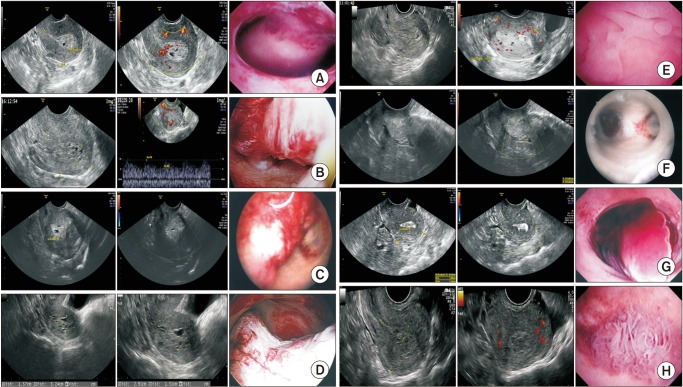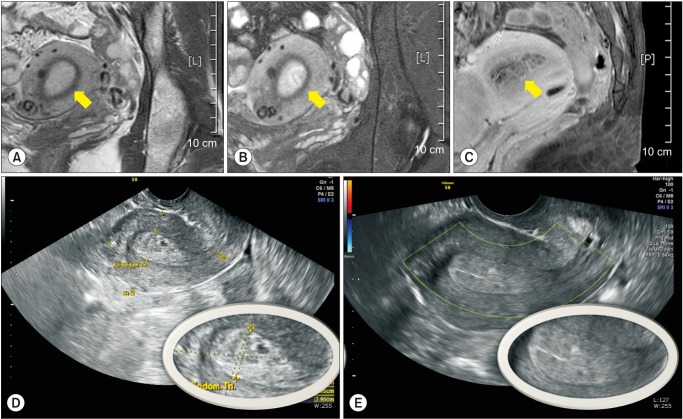J Menopausal Med.
2019 Dec;25(3):158-163. 10.6118/jmm.19015.
Thick “Swiss Cheese†Appearance of Uterine Endometrium in Postmenopausal Women with Different Gynecologic Conditions
- Affiliations
-
- 1Department of Obstetrics and Gynecology, Asan Medical Center, University of Ulsan College of Medicine, Seoul, Korea. leesr@amc.seoul.kr
- KMID: 2466831
- DOI: http://doi.org/10.6118/jmm.19015
Abstract
OBJECTIVES
To uncover gynecologic conditions with similar transvaginal sonographic findings of thick uterine endometrium with honeycomb appearance in pre-and postmenopausal women.
METHODS
We retrospectively reviewed cases of patients with endometrial tissue biopsy from January 2010 to December 2016. We also collected office flexible hysteroscopic findings and surgical pathologic results. We analyzed data from 393 patients with confirmed endometrial pathology. Among these patients, 69 had transvaginal ultrasonographic images with thick uterine endometrium and honeycomb or "Swiss cheese" appearance.
RESULTS
We found gynecologic conditions such as submucosal leiomyoma with degeneration, endometrial polyp, pseudocystic endometrial change associated with tamoxifen use, progesterone associated endometrial change, pyometra, retained placenta, and uterine synechiae manifested with similar thick endometrium with "Swiss cheese" appearance in transvaginal sonographic images. The most common diagnosis in postmenopausal women was atrophic endometritis, followed by endometrial cancer and endometrial polyps. The most common diagnosis in premenopausal women was abnormal uterine bleeding without pathologic conditions.
CONCLUSIONS
Sonographic findings of thick uterine endometrium with "Swiss cheese" appearance need to be considered together with a thorough review of the patient's history and chief complaint before making a tentative diagnosis due to the various conditions sharing the feature.
Keyword
MeSH Terms
Figure
Reference
-
1. American Institute of Ultrasound in Medicine (AIUM). American College of Radiology (ACR). American College of Obstetricians and Gynecologists (ACOG). Society for Pediatric Radiology (SPR). Society of Radiologists in Ultrasound (SRU). AIUM practice guideline for the performance of ultrasound of the female pelvis. J Ultrasound Med. 2014; 33:1122–1130. PMID: 24866623.2. Norton ME, Scoutt LM, Feldstein VA, Callen PW. Callen's ultrasonography in obstetrics and gynecology. 6th ed. Philadelphia: Elsevier;2017. p. 839.3. American College of Obstetricians and Gynecologists. ACOG Committee Opinion No. 426: the role of transvaginal ultrasonography in the evaluation of postmenopausal bleeding. Obstet Gynecol. 2009; 113(2 Pt 1):462–464. PMID: 19155921.4. Doubilet PM. Society of Radiologists in Ultrasound Consensus Conference statement on postmenopausal bleeding. J Ultrasound Med. 2001; 20:1037–1042. PMID: 11587009.
Article5. Smith-Bindman R, Weiss E, Feldstein V. How thick is too thick? When endometrial thickness should prompt biopsy in postmenopausal women without vaginal bleeding. Ultrasound Obstet Gynecol. 2004; 24:558–565. PMID: 15386607.
Article6. Yela DA, Yoneda J, Brasil L. Uterine arteriovenous malformation after gestational trophoblastic disease: a report of two cases. J Reprod Med. 2014; 59:417–420. PMID: 25098034.7. Davidson KG, Dubinsky TJ. Ultrasonographic evaluation of the endometrium in postmenopausal vaginal bleeding. Radiol Clin North Am. 2003; 41:769–780. PMID: 12899491.
Article8. Bhaduri M, Tomlinson G, Glanc P. Likelihood ratio of sonohysterographic findings for discriminating endometrial polyps from submucosal fibroids. J Ultrasound Med. 2014; 33:149–154. PMID: 24371110.
Article9. Baldwin MT, Dudiak KM, Gorman B, Marks CA. Focal intracavitary masses recognized with the hyperechoic line sign at endovaginal US and characterized with hysterosonography. Radiographics. 1999; 19:927–935. PMID: 10464800.
Article10. Goldstein RB, Bree RL, Benson CB, Benacerraf BR, Bloss JD, Carlos R, et al. Evaluation of the woman with postmenopausal bleeding: Society of Radiologists in Ultrasound-Sponsored Consensus Conference statement. J Ultrasound Med. 2001; 20:1025–1036. PMID: 11587008.
Article11. Cohen JR, Luxman D, Sagi J, Jossiphov J, David MP. Ultrasonic “honeycomb” appearance of uterine submucous fibroids undergoing cystic degeneration. J Clin Ultrasound. 1995; 23:293–296. PMID: 7642767.
Article12. Takeuchi K, Tsujino T, Yabuta M, Morita H. Acute urinary retention caused by endometrial carcinoma with large cystic cervix. Arch Gynecol Obstet. 2011; 283 Suppl 1:73–75. PMID: 20711598.
Article13. Demirkiran F, Yavuz E, Erenel H, Bese T, Arvas M, Sanioglu C. Which is the best technique for endometrial sampling? Aspiration (pipelle) versus dilatation and curettage (D&C). Arch Gynecol Obstet. 2012; 286:1277–1282. PMID: 22766754.14. Williams AR, Bergeron C, Barlow DH, Ferenczy A. Endometrial morphology after treatment of uterine fibroids with the selective progesterone receptor modulator, ulipristal acetate. Int J Gynecol Pathol. 2012; 31:556–569. PMID: 23018219.
Article15. Bettocchi S, Baranowski WE, Doniec J, Ceci O, Resta L, Fascilla FD, et al. Hysteroscopic patterns in women on treatment with ulipristal acetate 5 mg/day: a preliminary study. J Minim Invasive Gynecol. 2016; 23:664–669. PMID: 26803918.16. Chalas E, Costantino JP, Wickerham DL, Wolmark N, Lewis GC, Bergman C, et al. Benign gynecologic conditions among participants in the Breast Cancer Prevention Trial. Am J Obstet Gynecol. 2005; 192:1230–1237. discussion 1237-9. PMID: 15846210.
Article17. Fisher B, Costantino JP, Redmond CK, Fisher ER, Wickerham DL, Cronin WM. Endometrial cancer in tamoxifen-treated breast cancer patients: findings from the National Surgical Adjuvant Breast and Bowel Project (NSABP) B-14. J Natl Cancer Inst. 1994; 86:527–537. PMID: 8133536.
- Full Text Links
- Actions
-
Cited
- CITED
-
- Close
- Share
- Similar articles
-
- Gynecologic Disorders in the Older Adults
- Estrogen Receptor Gene PvuII and XbaI Polymorphisms and Ultrasonographic Findings of Uterine Endometrium in Postmenopausal Women with Hormone Replacement Therapy
- The Correlation between the Endometrial Cancer and Postmenopausal Uterine Bleeding
- The effects of Raloxifene therapy on endometrium in postmenopausal women
- Comparative Study on Hysteroscopic and Histologic Examinations of the Endometrium in Postmenopausal Women Taking Tamoxifen





